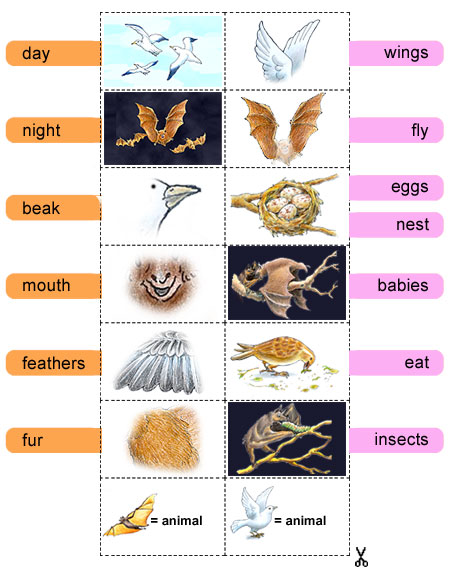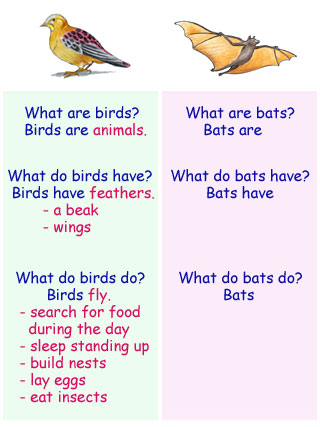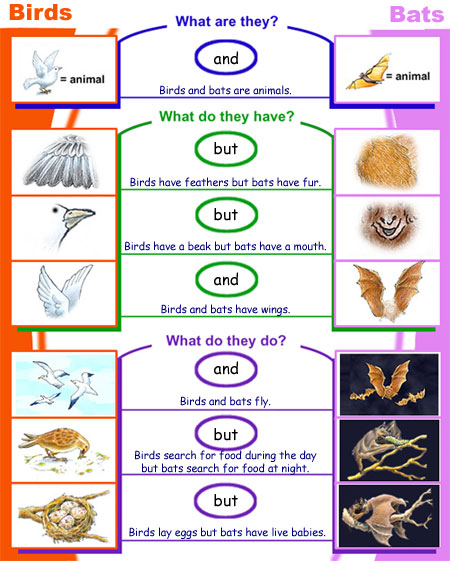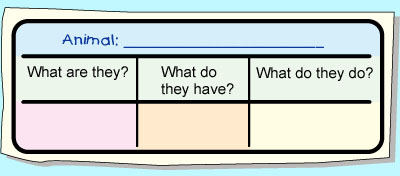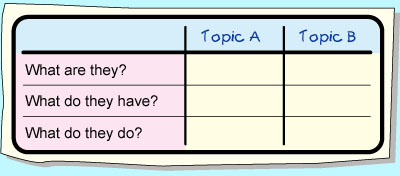|
Common vocabulary |
|||
| eat | sleep | ||
| fly | wings | ||
| insects |
|||
|
Birds |
Bats |
||
| beak | babies | ||
| day | fur | ||
| feathers | hang upside down | ||
| nests | mouth | ||
| stand up | night |
||
| Birds are animals. | |
| Birds have feathers. | |
| Bats have fur. | |
| Birds search for food during the day. | |
| Bats search for food at night. | |
| Birds eat insects. | |
| Bats eat
insects. |
| Connectives are words
that show the relationships between ideas within sentences and between
sentences: |
|
| And links similar ideas and adds information. | |
| But
links contrasting ideas. |
|
| Birds and bats are animals. | |
| Birds and bats fly. | |
| Birds and bats eat insects. | |
| Birds have feathers but bats have fur. | |
| Birds have a beak but
bats have a mouth. |
|
Common vocabulary |
|||
| eat | sleep | ||
| fly | wings | ||
| insects |
|||
|
Birds |
Bats |
||
| beak | babies | ||
| day | fur | ||
| feathers | hang upside down | ||
| nests | mouth | ||
| stand up | night |
||
| Birds are animals. | |
| Birds have feathers. | |
| Bats have fur. | |
| Birds search for food during the day. | |
| Bats search for food at night. | |
| Birds eat insects. | |
| Bats eat
insects. |
| Birds and bats are animals. | |
| Birds and bats fly. | |
| Birds and
bats eat insects. |
| Birds have feathers but bats have fur. | |
| Birds have a beak but
bats have a mouth. |
Materials
| Note: | Make one A3 colour copy of both the Bat and
Bird pictures to display to the whole class. If you wish to
re-use these pictures, you may like to make them more durable by sticking
them onto cardboard before the lesson, or by laminating them. |
| Note: | You will need to make one A3
size copy of the Vocabulary and Compare and contrast worksheets and one A4
copy of the Picture cards for every pair of students. |
| Note: | You will need to prepare one copy of the Compare
and contrast worksheet enlarged to A3 and a colour copy of Picture cards to display
on the board. You may want to stick the materials onto card or laminate
them to make them more durable. |
Steps
| Glossary: | Brainstorming
is an activity whereby students are expected to come up with as many ideas
as possible within a time limit. The time limit is usually between one and
five minutes. The activity gives teachers the opportunity to find out what
students already know about the topic. Such information helps the teacher
to assess what needs to be taught in order for students to achieve the
outcome of the task (ie comparing and contrasting bats and birds).
Brainstorming is also a good activity for helping students to gather ideas. |
|||||||||||||||||
| 1. | Note: |
It is important that the board is organised well for
this lesson. Designate one side of the board for bats and the other for
birds. Place the pictures at the top of the board and make sure you have
room to add information underneath. |
||||||||||||||||
| 1. | Example: | Make sure that you emphasise the contrasting
final sounds in the words bats: Some final consonant sounds can be problematic for students. This is because in Cantonese the sounds are not usually released, but in English they do need to be released. If students do not articulate the sounds fully in English, they may have difficulty in being understood by other speakers of English. The following features of English pronunciation are significant when pronouncing the words bats and birds.
|
||||||||||||||||
| 1. | Theory: |
In a pronunciation
drill the teacher models the pronunciation of a
word or words and students repeat the words several times. The teacher
should use hand
gestures to direct the drill, so that the only sounds students hear are the
ones they are practising. If the speed and pattern of the drill are
varied, students will stay focused on the activity.
Here are the steps of a very simple drill:
|
||||||||||||||||
| 1. | Theory: |
The purpose of this activity is to find out what students already know about the
topic and to activate their existing language knowledge. |
||||||||||||||||
| 1. | Adaptation: |
If this activity is too difficult for your students miss out Steps 1and 2 and start
at Step 3. |
||||||||||||||||
| 2 | Example: |
|
||||||||||||||||
| 3. | Note: |
During pair work activities it is important to encourage students to talk to each other in English about the activity and about the decisions they are making. You may need to teach your students the language they need to discuss classroom activities with their classmates. Here are some examples which may be useful here:
|
||||||||||||||||
| 3. | Theory: |
Monitoring helps the teacher to identify problems that need to
be dealt with on an individual basis. It also enables the teacher to make a note
of problems that are common to many students. These problems can then be focused
on during whole-class feedback. |
||||||||||||||||
| 3. | Key: |
There may be several different ways to match the Picture cards with the Vocabulary cards. It is not necessary to insist that students match them in this way:
|
||||||||||||||||
| 4. | Example: |
|
||||||||||||||||
| 5. | Example: |
|
||||||||||||||||
| 5. | Example: |
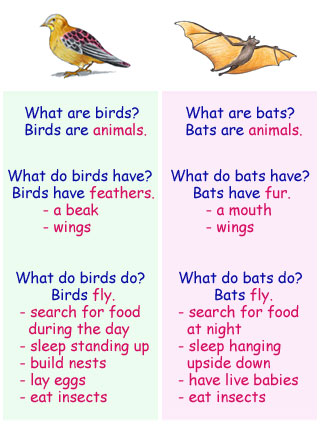
|
||||||||||||||||
| Note: |
For this step you will need a display copy of the Compare
and contrast worksheet enlarged to A3 size, as well as one set of picture cards
which have been cut out for students to stick on the display. |
|||||||||||||||||
| 7. | Example: |
|
||||||||||||||||
| 9. | Example: | 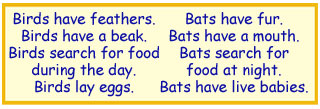
|
||||||||||||||||
| 9. | Example: |
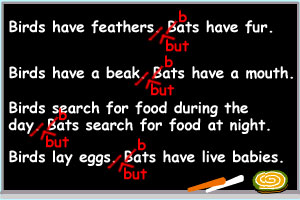
|
||||||||||||||||
| 9. | Example: |
|
||||||||||||||||
| 10. | Key: |
|
||||||||||||||||
| 10. | Note: | There may be more than one
way of ordering the pictures. If a pair of students can
demonstrate that their layout answers the questions effectively, do not
insist that they lay their pictures out according to the key. |
||||||||||||||||
| 11. | Theory: |
You can give students a feeling of pride and satisfaction in what they
have achieved in English by displaying their work in the classroom or in
other places in the school, or by asking them to read out their work to
the class. This can enhance students' motivation to learn English. |
Web ideas
| Glossary: |
A graphic organiser is used to help students to record and organise information they are gathering as they listen or read. The pattern of a graphic organiser is determined by the student's purpose for collecting the information. It may often be in the form of a grid or table, but can also be a timeline, a story line, a flowchart, a tree diagram or a mind map. Here is a table students can use to organise vocabulary about an animal:
Here is a table students can use to organise vocabulary for comparing and contrasting different topics:
|
Grammar notes
For more information on using the present simple, look at the following in PrimeGram:
| Grammar: Groups & phrases: Verb group: Time & tense: Present simple |
For more information on using connectives, look at the following in PrimeGram:
| Grammar: Word classes: Conjunctions: Overview |
For more information on using communicative functions for making comparisons, look at the following in PrimeGram:
| Communicative functions: Talking about experience: Who or what is involved?: Making comparisons |
For more information on using communicative functions for making connections, look at the following in PrimeGram:
| Communicative functions: Talking about experience: Making connections |
For more information on general descriptions as a text type, look at the following in PrimeGram:
| Text types: General descriptions: Overview |
![]()

